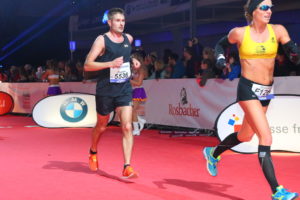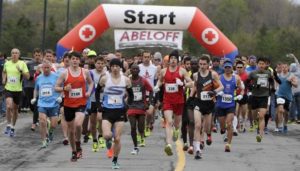 Before you decide to be a “streaker,” pause for a hot second and ask yourself WHY? This time of year, running streaks are very popular. It makes sense. It’s getting colder, its often dark, peak goals are in the past, and runners are looking for motivation or accountability to be active. Toss in social media, and most runners will decide to commit to a streak without a second thought.
Before you decide to be a “streaker,” pause for a hot second and ask yourself WHY? This time of year, running streaks are very popular. It makes sense. It’s getting colder, its often dark, peak goals are in the past, and runners are looking for motivation or accountability to be active. Toss in social media, and most runners will decide to commit to a streak without a second thought.
Here’s the problem: there are times when you should absolutely, 100% take a complete rest day. In fact, it’s irresponsible and plain stupid to not. Streaks, by definition, mean no rest or off days for said duration. Sure, some streaks only require a mile a day, and others more. Yes, you could go take that mile or 5K super easy. But why, if your body is saying “PLEASE FOR THE LOVE OF GOD, NO!!!,” do we blindly stick to the streak? I’ve heard of runners plagued by the flu lace up their shoes and drag their carcass on a run because they didn’t want to break their streak. Runners taping up an injured quad to get in their miles. Take a step back with me. Doesn’t that sound absolutely insane?
The whole “no rest days” thing is not something a coach would EVER support. I don’t understand why runners think that it makes them badass or dedicated to train everyday. Again, it makes you stupid. Because REST is when we rebuild from the training. Rest is just (if not more!) important than some of the runs. Rest greatly reduces injury risk. I don’t know if many streakers or “no rest day” folks out there who don’t wind up injured. And you guessed it – they are injured because of their looney training choices.
I see plenty of other reckless goals out there: a marathon a month. A half marathon in every state in a calendar year. The goal of clocking 2000 miles in the year. Can some runners do those things? Absolutely. But should they, or should you? The risk is really high. Wouldn’t it perhaps be more reasonable to plan to run 4 marathons a year, and think long term? For the record, 4 marathons is still a lot for most marathoners. It’s fine to attempt something. We don’t surpass our goals or expectations without risk. But measured risk over reckless risk. Remember that just because somebody else can do something, it doesn’t mean you can. We are all incredibly unique. Focus on yourself, not your running buddy.
In NYC, I deal with a ton of runners who partake the NYRR’s 9+1 program. Essentially, you run 9 races and volunteer at one event in a calendar year, in exchange for a guaranteed spot in the NYC Marathon. I understand the reasons behind the system, but as a coach, I despise the 9+1 concept. I’ve encountered dozens of runners who should not be lacing up for a run anytime soon, dragging their bodies through a required race. The injuries that could have been avoided are compromised because of that damn race on their calendar. It’s a struggle to guide an athlete towards their goals, but to toss in an navigate 9 races in the mix. Sure, some are easy. Others, not so much. The amount of times I have “highly advised” a runner to sit out a 10K or the 18-mile tune-up race for their own benefit, but they “need” to do it for their marathon spot – far more frequent than I care to admit.
It’s important to understand that running can be a life-long journey. It can be a journey with few injuries or burnout. But it can also be a short and tumultuous journey if taken fast and furious. This isn’t to say you should not do the 9+1 or to decide to go for a running streak. But don’t lose sight of the big picture. Is running everyday in December worth potentially having no spring race season? Listen to your body, and be ready to toss the streak if your body tells you to.
 First and foremost, I apologize for neglecting my blog for much of 2017. That’s about to change! Second, it has been an incredible year. I am so humbled and proud of the hard work my roster have brought to the table. It’s an honor to do what I do every day.
First and foremost, I apologize for neglecting my blog for much of 2017. That’s about to change! Second, it has been an incredible year. I am so humbled and proud of the hard work my roster have brought to the table. It’s an honor to do what I do every day. I would absolutely recommend Frankfurt Marathon to anyone looking for a flat and fast marathon. It was a pretty amazing day. And the days following the marathon were really fun. Food and drink is everywhere. If you enjoy baked goods and beer, Germany is for you. Frankfurt is an incredibly friendly city to travelers from all over the globe.
I would absolutely recommend Frankfurt Marathon to anyone looking for a flat and fast marathon. It was a pretty amazing day. And the days following the marathon were really fun. Food and drink is everywhere. If you enjoy baked goods and beer, Germany is for you. Frankfurt is an incredibly friendly city to travelers from all over the globe. Every once and a while I get a request for a blog topic. Today I am indulging myself to fulfill a recent request. One of my regulars at
Every once and a while I get a request for a blog topic. Today I am indulging myself to fulfill a recent request. One of my regulars at  On May 15th I ran my first solo marathon since Boston 2015. My goal was simple: lock in a BQ. While I felt pretty confident I’d complete a 3:15-3:30 marathon, a whole lot can happen in the course of 26.2 miles. Plus, this marathon was a short two weeks since my “A” race for 2016, the Broad Street Run.
On May 15th I ran my first solo marathon since Boston 2015. My goal was simple: lock in a BQ. While I felt pretty confident I’d complete a 3:15-3:30 marathon, a whole lot can happen in the course of 26.2 miles. Plus, this marathon was a short two weeks since my “A” race for 2016, the Broad Street Run.



